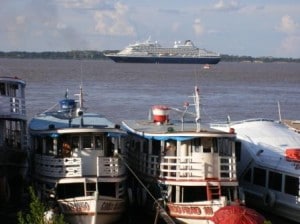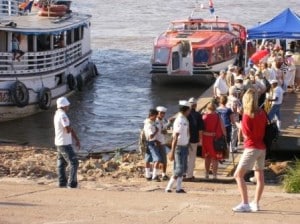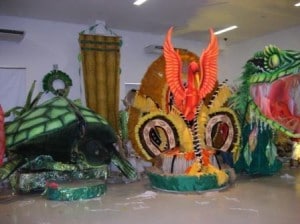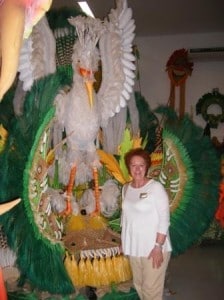Moving down the river always has the feeling that things go a lot faster. This is certainly the case in the rainy season when the Amazon current can reach a velocity of up to four knot, but even now a current of around 2 knots it gives a nice push in the back. Although the average speed might remain the same, it gives the same feeling as when walking with or against the wind. Also it saves an engine to make the speed required and that helps greatly with the fuel consumption. 100 miles south of Manaus is the Itacotiara pilot station where we switched pilots again. The two “Manaus” pilots left and the two “river pilots” joined. They will stay with us until Macapá where the Amazon starts & ends for compulsory Pilotage and which is 170 miles upstream from the Amazon Bar, there where the Amazon waters meet the North Atlantic Ocean.
 It is nearly 3/4 of a mile from the safe anchor position to the shore side.
It is nearly 3/4 of a mile from the safe anchor position to the shore side.
When I went up and down the river with the Veendam in 2007 I was able to dock in Parintins, where they had just installed a new floating dock/pontoon of 160 meters long. When I cam back here in March 2010, the dock had been “condemned” by the navy, who owns the dock depending a steel investigation. At least that was what the pilots managed to convey to me in their best English. When we arrived this time, the pontoon was still there to my surprise but when closely looking at it through the binoculars I saw that the middle part of the ramp that leads to the pontoon had been removed for repair. So maybe next time I will be able to dock again, as anchoring is a real hassle for the guests and in this port a major operation for the deck department.
 A long and steep track up the hill due to the low water. Boy scouts at hand to assist where needed.
A long and steep track up the hill due to the low water. Boy scouts at hand to assist where needed.
The problem lies in the fact that with anchoring we have to park ourselves on the edge of the bank in the middle of the river. Parintins is located in a south bend of the Amazon and the brunt of the current passes by fairly close to the port area. That also means that the water is there the deepest; up to 50 meters. Not a good area to anchor and thus we have to go to the middle of the river, where there is a bank located 10 meters under water and the current not more than a knot in average strength. The anchor maneuver is quite interesting in itself when coming from up river. About two miles above the anchorage position, you start the turn and while being pushed down stream by the current, you turn 180o until you face upstream again. The trick is to start the turn at the exact right moment so that you end up south of the anchorage, but not too far, otherwise you have to steam al the way back again. Then you slowly move in the direction of the bank, until the echo sounder tells you that you have arrived at the preferred depth. The anchor goes down and the current keeps the ship straight behind the anchor chain.
 Boi-Bumba costumes and props on display.
Boi-Bumba costumes and props on display.
The tender service is the next challenge as we have to cross the navigable part of the river where all the traffic sails by, all the dead trees and other debris floats by and where the current is the strongest. We can accomplish a regular tender service only safely with having an officer on each tender all day and the chief officer on the bridge. From that high vantage point, he can see all traffic approaching but can also see the dead trees, the latter which can hardly be seen from the tender low on the water.
 These are not small costumes and props either. roving reporter Lesley next to one of the animals used in the show.
These are not small costumes and props either. roving reporter Lesley next to one of the animals used in the show.
Shore side is a challenge for the guests as due to the low water level it is a steep climb up to the town. A nice touch of hospitality is the presence of the boy scouts all day who help guests up and down the ramp. A gesture much appreciated and we kept them well supplied with water, sandwiches and a little gift at the end of the day.
Main reason for stop here is the tour to the Boi-Bumba festival/show which can be compared to the Carnival parade in Rio, but is the re-enactment of a local legend. The costumes are very special and ¾ our guests book the show.
By 1700 hrs. we were on our way again towards our last port of call Alter do Chao, which is something totally different as it is a holiday resort located near Santarem. I will be there at sunrise, thus very early as we have to find our anchorage by echo sounder and then send our first tender ashore with advance party to find a pier, make it fit for use and otherwise built one. An Amazon cruise is and remains an expedition

Leave a Reply